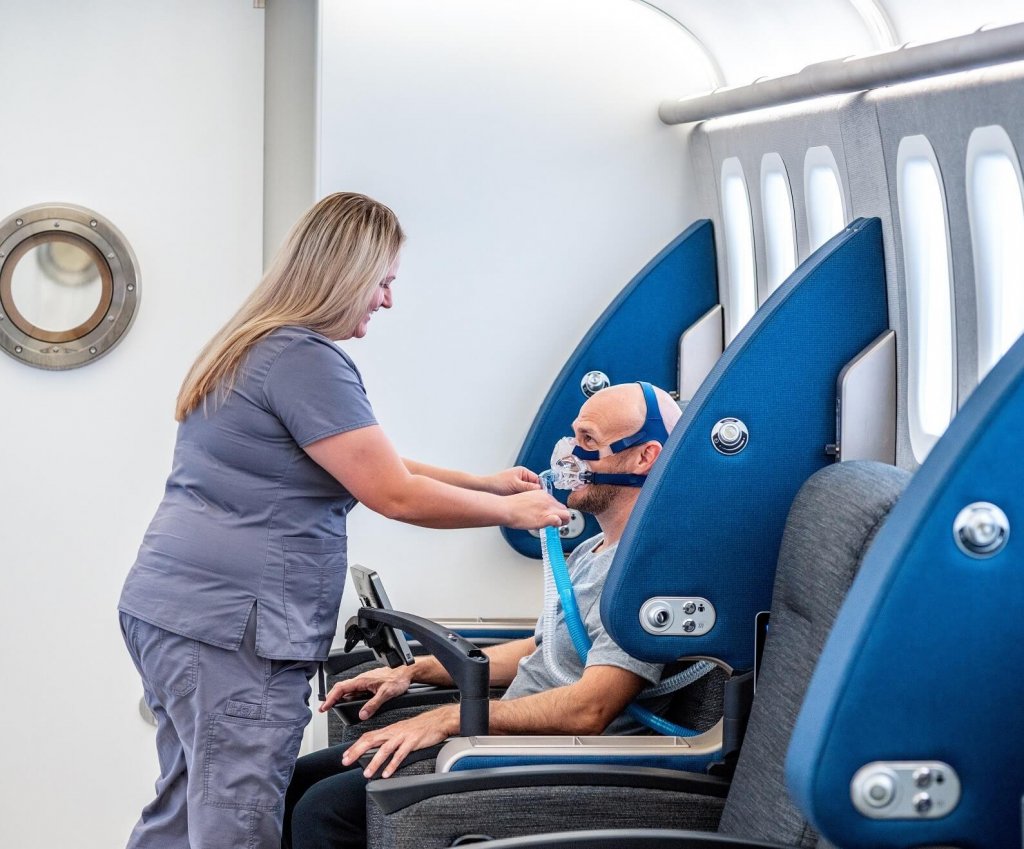HBOT for Athletes: Boosting Performance, Speeding Recovery, and Preventing Injury
HBOT for Athletes: Boosting Performance, Speeding Recovery, and Preventing Injury
Athletes are always looking for their next win, whether they are at the professional level or a weekend warrior. But, in doing so, they also encounter several challenges. Fatigue and injuries can seriously damage one’s competitive edge. In some cases, an injury or recurring injury forces athletes to abandon their sport entirely.
In recent years, hyperbaric oxygen therapy (HBOT) has emerged as an effective way to address injuries, aid in recovery, and improve athletic performance, both mentally and physically. Even if you’re an amateur athlete who is just passionate about your sport of choice, HBOT is a viable way to take your performance to the next level.
How Can Hyperbaric Oxygen Therapy Help Athletes?
Hyperbaric oxygen therapy can help athletes by:
- Enhancing physical performance and endurance
- Improving mental clarity and cognitive function
- Supporting better sleep and recovery
- Increasing energy and stamina
- Speeding up healing from injuries
- Reducing inflammation and preventing re-injury
As one of the largest and most advanced hyperbaric treatment centers in the world, Aviv Clinics has enhanced performance in athletes ranging from amateurs to elite professionals. Continue reading to learn more about the hyperbaric oxygen therapy benefits for athletes and how you can get started.
4 Ways Hyperbaric Oxygen Therapy Enhances Athletic Performance
There are four main HBOT benefits for athletes.
1. HBOT Can Boost Strength, Endurance, and VO2 Max
Studies speak volumes about HBOT’s transformative impact on physical athletic performance:
- Higher strength and endurance
- Increase mitochondrial efficiency
- Enhance maximal oxygen consumption (VO2 max)
- Contributes to faster healing after an injury
- Expedites recovery from non-injury soreness
- Reduces the incidence of injury occurrence or reoccurrence
- Breaks up the cycle of inflammation that athletes often experience
Hyperbaric chamber benefits don’t stop there.
Watch NFL neurosurgeon Dr. Joseph Maroon explain why he not only recommends the hyperbaric oxygen protocols of the Aviv Medical Program to patients with concussive injury to the brain, but also how his own participation in the program has improved his athletic performance and recovery times.
2. HBOT Can Increase Mental Clarity and Reaction Speed
Cognitive performance, which is a foundational focus of the Aviv Medical Program, plays a crucial role in athleticism. Intensity, focus, and attention support the physical fundamentals of a sport.
Research illustrates that patients who have undergone HBOT experience improvement in areas such as attention, focus, and information processing speed—all of which contribute to better athletic performance.
Two athletes who previously completed HBOT have spoken openly about its benefits.
Peter Paltchik is a Judo champion who was not just looking to maximize his physical capacity, but also his cognitive fortitude. Paltchik describes the program as his “ace card” to success:
“To be an Olympic medalist, every second counts. You must be able to analyze, to react, to think very quickly. This is the difference between winning and losing. In order to be the most complete athlete and the best fighter I can, I must have the best cognitive capabilities such as handling extreme levels of stress, concentration, making decisions in real time. After I joined the program, I felt the improvements in my mind and body. I was sharper, more focused in fights, and I was able to make quicker decisions.”
Alon Day, a four-time European NASCAR champion, also benefited from the program. Unlike other sports, race car driving is about intense, small motor movements. Drivers require significant grip strength to control the steering wheel at high speeds. Small movements of the hand and foot can make the difference between finishing first or crashing. The environment also takes a physical toll, as drivers wear a fireproof suit with no air conditioning, which can lead to dehydration.
Racing requires intense cognitive focus for an extended period. This is one area where Day made significant strides. After completing the Aviv Medical Program, Alon achieved approximately 15% improvement in cognitive function.
“There is nothing like it in the world. You cannot go to the gym and get the same results. When I came over there every morning, I felt like I was a bionic man, being in the hyperbaric chamber at the cutting edge of medicine. At the end of the hyperbaric treatment, when the season started, I was at my best. I won the championship, and I broke every record. In my opinion, this treatment is for whoever needs to be on top of their game.”
3. HBOT Enhances Sleep Quality and Recovery
Sleep is imperative to restoring the body after a hard workout. But sometimes, depending on injuries, daily stressors, and the pressure athletes face, getting consistent, quality sleep is easier said than done.
The good news is that research indicates the cognitive and physical improvements that come with HBOT help improve sleep quality. This has also been the case for those who have suffered from long COVID and experienced chronic insomnia.
4. HBOT Elevates Energy and Stamina Levels
HBOT encourages the body to heighten its aerobic stamina, including lung capacity and cardiovascular endurance. The exciting part about the therapy is that it focuses on helping individuals of all ages.
Watch PGA Tour golfer and Ryder Cup winner Tommy Fleetwood as he describes his experience with the Aviv Medical Program:
When 14-year-old Linden Perry suffered from post-concussion syndrome due to a sports injury, she regained her health and performance through a holistic treatment program—one that entailed HBOT, cognitive, and physical training. The personalized treatment plan left Perry more energized and gave her the confidence to continue to excel in her athletic programs.
Choosing the Right Type of HBOT for Athletes
While all hyperbaric chambers have the same goal, to deliver 100% oxygen in a high-pressure environment, not all chambers are created equally. There are different types of chambers that each possess a unique process.
Monoplace Chambers: Pros and Limitations
- Monoplace chambers administer oxygen to one person at a time. The chamber’s structure reflects a tube or cylinder in which individuals lie in a horizontal position while the chamber is typically compressed with 100% oxygen.
- Soft-side monoplace chambers are more “portable” than the rigid cylindrical HBOT chambers made of glass or plastic. These chambers, however, cannot reach the level of pressurization to produce high-level results.
But neither of these chambers is manufactured with the intent of offering oxygen fluctuation, which peer-reviewed published studies reveal is a key technique to optimizing results from HBOT.
Multiplace Chambers: Optimal for Athletes
Multiplace chambers or “suites,” such as the one at Aviv Clinics in The Villages, Florida, can utilize the science behind oxygen fluctuations in a pressurized environment. This mechanism produces the underlying elements of enhanced athletic performance. Research indicates that this specialized protocol, known in the scientific community as the hyperoxic-hypoxic paradox, can produce:
- Stem cell proliferation and differentiation. Stem cells can exist as any cell type in the human body. As it relates to physical performance, stem cell production supports the heart, lungs, and muscles. Lungs breathe deeper and more efficiently, allowing athletes to perform at a higher level for longer periods without becoming winded. The heart is able to pump out more oxygenated blood to other organs and muscles, and muscle growth occurs at a faster pace.
- Hypoxia-inducible factor (HIF). HIF plays a role in angiogenesis, or the creation of new blood vessels. With more routes for blood to travel throughout the body — to the heart, lungs, and muscle tissue — more oxygen is also getting to those areas. This prevents fatigue and muscle soreness. HIF is also instrumental in creating new red blood cells, ensuring that maximum oxygen flow goes to the organs.
- Vascular endothelial growth factor (VEGF). VEGF is a protein that gets released during HBOT treatments and “signals” blood vessel formation. Again, the more blood that can flow to key areas of the body, the higher one’s athletic capacity.
Maximizing HBOT for Athletes with a Holistic Program
For any athlete looking to reap the benefits of a hyperbaric chamber, it’s not just about the oxygen or even the oxygen fluctuations. Athletes need to incorporate additional components to reach their full potential.
Paltchik and Day both experienced brain-based enhancements thanks to the cognitive training element of the Aviv Medical Program. Nutritional coaching and physical training are other areas that can help athletes push their bodies to maximum output. That’s why the Aviv Medical Program can be personalized for each individual client.
A personalized program considers variables like an athlete’s unique biology, medical history, and performance goals to create a customized prescription for treatment.
How to Maximize Your Athletic Performance With HBOT
In short, to get the most out of HBOT as an athlete:
- Choose a clinic that uses fluctuating oxygen protocols (the hyperoxic-hypoxic paradox)
- Combine HBOT with cognitive and physical training
- Follow a personalized treatment plan tailored to your sport
- Incorporate nutrition coaching for energy and recovery
- Track your progress with performance metrics
The Bottom Line: Personalized HBOT for Athletic Performance
Whether you are a professional athlete or simply want to advance your athletic capabilities to their best potential, HBOT can help. To truly transform your game, the personalized approach of the Aviv Medical Program is second to none in achieving peak performance.
Athletes who go through the Aviv Medical Program may undergo HBOT along with physical, cognitive, and nutritional training. This holistic program is key to helping our patients enhance their health for the long run.
Contact us to learn more about how the Aviv Medical Program can help you achieve your goals.
Last Updated July 14, 2025
Hyperbaric Oxygen Therapy for Stroke Recovery: Reignite Healing in the Brain
Stroke is a leading cause of serious long-term disability in adults, with nearly 800,000 Americans experiencing one each year. Whether it’s an ischemic stroke or a transient ischemic attack (TIA), recovery depends heavily on timely, effective treatment. Even with timely intervention, however, many survivors are left with lingering effects, like reduced mobility, impaired speech and vision, and cognitive challenges. While no treatment can reverse damage to dead brain cells, exciting advancements in stroke rehabilitation are showing promise, especially hyperbaric oxygen therapy (HBOT). The Aviv Medical Program uses hyperbaric oxygen therapy for stroke recovery as part of a personalized, multidisciplinary treatment plan to help achieve measurable improvements, even years after a stroke.
What Happens to the Brain during a Stroke?
When a stroke strikes, blood flow to the brain becomes interrupted, causing death to brain cells due to loss of blood and oxygen. As many as two million brain cells die each minute a stroke goes untreated. Other cells become injured but don’t necessarily die off. Neurologists often describe them as being “stunned” in this area of the brain, known as the penumbra.
The combined damage from injured and necrotic (dead) brain cells results in both immediate and long-term symptoms such as:
- Limb weakness or paralysis
- Slurred speech
- Vision complications
- Balance issues.
Once brain cells (neurons) have died, they cannot be revived, which is why timely intervention is so critical. However, a growing body of research indicates that HBOT may help repair the injured or stunned cells, even years after the initial stroke
How Can Hyperbaric Oxygen Therapy (HBOT) Support Brain Recovery?
Hyperbaric oxygen therapy (HBOT) is a type of therapy that uses pressurized chambers to allow individuals to breathe in 100% pure oxygen. The increased pressure in the hyperbaric environment allows for more oxygen to be dissolved in the blood and tissues. When administered using certain protocols, HBOT can raise oxygen levels in the body to about 17 times higher than normal. This allows oxygen to be delivered even to dormant cells, such as those injured by stroke.

How Does HBOT Help with the Post-Stroke Recovery Process?
Hyperbaric oxygen therapy (HBOT) supports stroke recovery by increasing the amount of oxygen delivered to injured brain tissue. When administered using a research-backed protocol, HBOT has been shown to:
- Promote healing in stunned or dormant brain cells
- Stimulate the growth of new blood vessels (angiogenesis)
- Activate stem cells to support tissue repair
- Trigger neuroplasticity—creating new neural connections
- Improve cognitive, speech, and motor function in stroke survivors
These benefits are particularly valuable for stroke survivors.
Fluctuating Oxygen Protocol: The Aviv Approach to HBOT
Based on nearly two decades of peer-reviewed, published research, the unique HBOT protocol at Aviv Clinics deliberately and safely fluctuates oxygen throughout the HBOT session. Patients receive treatment in a multi-person suite, accompanied by a medical professional. The suite is filled with medical-grade air, and clients breathe 100% oxygen through a mask. Thus, when the mask is on, oxygen levels in the body are very high. But when the oxygen mask is removed so patients can breathe normal air, the body is deceived into sensing a low-oxygen state.
This fluctuation triggers the body to believe it has become hypoxic, and it shifts into repair and regeneration mode. Research shows that this HBOT protocol can prompt neurological recovery even years after an initial stroke.

Real Results: Stroke Survivor Improvements with HBOT at Aviv
Several studies have proven the benefits of using HBOT in post-stroke recovery. When this specific HBOT protocol is combined with the broader Aviv Medical Program, results can be life-changing. Stroke survivors treated at Aviv Clinics have reported:
- Restored speech and reading capabilities
- Improved motor function, even with partial paralysis
- Greater independence in performing daily activities
Some clients have improved from using a wheelchair to walking with a cane. Others have regained communication skills they thought were lost forever. Many say the biggest benefit is no longer feeling like a burden to their loved ones.
The Personalized Aviv Medical Program for Stroke
When incorporated into the Aviv Medical Program, the outcomes become even more impressive:
- Some Aviv clients have progressed from using wheelchairs to walking on their own or with an assistive device.
- Clients who have lost their ability to speak can make immense recovery strides.
- Many report that the biggest benefit is simply not being a “burden” on their loved ones.
The Aviv Medical Program is grounded in nearly two decades of rigorous clinical research and built around a highly personalized approach to treatment. We begin with an in-depth evaluation designed to uncover the sources of your cognitive and physical challenges after your stroke. After an in-depth review of your health history and a physical exam, your Aviv Clinics physician may also recommend:
- Advanced brain imaging (MRI and/or SPECT)
- Body composition analysis
- Neurological and neurocognitive evaluations
- Physical and functional performance testing
From there, your dedicated medical team will design a customized treatment plan tailored to your unique condition, symptoms, health history, and recovery goals. Depending on your needs, your Aviv Medical Program may include:
- Hyperbaric oxygen therapy using our unique, scientifically-backed protocol
- Cognitive exercises to support brain performance
- Physical training and physical therapy
- Nutritional coaching to optimize energy, focus and healing
Learn more about the program>>
When to Begin Hyperbaric Oxygen Therapy After a Stroke
Aviv Clinics generally recommends waiting 3-6 month after a stroke before beginning hyperbaric oxygen therapy for stroke recovery. This allows for the brain’s natural healing process to stabilize before starting intensive therapy.
The sooner stroke survivors act after the post-acute stage, the better. Research shows that the greatest gains typically are seen when treatment begins less than four years post-stroke. That said, scientists have documented success even in clients who began treatment up to 10 years into their stroke recovery.
Expected Timeline to See HBOT Results
Most people see improvement from the Aviv Medical Program within 8-12 weeks. However, the individualized nature of the Aviv Medical Program means that outcomes and timelines vary. Our physicians prescribe a personalized treatment plan based on thorough assessments, your symptoms and medical history, and your treatment goals. This helps to ensure meaningful, measurable progress as you complete the program.
For most clients, here’s what the Aviv Medical Program looks like
- Step 1: Assessment— A set of assessments recommended by your Aviv Clinics physician to set baselines and establish your program.
- Step 2: Treatment— Based on the assessment, we develop a customized routine that can combine hyperbaric oxygen sessions with other types of personalized interventions. In most cases, stroke patients complete treatment over the course of 12 weeks.
- Step 3: Analysis— At your request, our team can repeat the tests from your initial assessment and measure your progress. A post-assessment will also enable our physicians to make recommendations for ongoing recovery.
Client Story: Keren’s Post-Stroke Transformation
After suffering an ischemic stroke, Keren Trabelsi, a busy executive, was left with cognitive issues and paralysis on the left side of her body. Daily tasks grew more difficult, which left her feeling defeated.
Overwhelmed and discouraged, Keren discovered the Aviv Medical Program. Following three months of hyperbaric oxygen therapy for stroke recovery alongside other interventions, Keren regained her ability to walk comfortably, type, and enjoy mental challenges like Sudoku once again. In her words, treatment at Aviv is “…like driving a Ferrari on the road to recovery versus driving like an old beaten-up car….”
Reclaim Brain & Body with Aviv’s Scientifically Backed Stroke Program
Stroke recovery doesn’t need to end with basic rehabilitation. The Aviv Medical Program offers a comprehensive, scientifically backed pathway to better physical and cognitive performance.
If you or a loved one is living with post-stroke challenges, our team is here to help. As the largest and most advanced civilian hyperbaric medicine treatment center in the United States, our expert clinical team is ready to discuss how the Aviv Medical Program may benefit you or your loved one. Contact us to learn more.
Last Updated July 14, 2025
8 Questions to Ask Before Starting Hyperbaric Oxygen Therapy
Hyperbaric oxygen therapy (HBOT) is growing in popularity, as recent research has highlighted its ability to improve cognitive performance, physical recovery, and even potentially reverse aging biomarkers. But it’s important to understand that not all HBOT programs are created equal. From hospital wound care clinics to medi-spas promising to heal anything and everything, the types of HBOT available today vary widely in safety, science, and effectiveness. No matter where you’re considering treatment, there are important hyperbaric oxygen therapy questions you should ask first.
As more HBOT facilities open around the United States, it has become increasingly important to understand the differences and identify the option best able to meet your health goals and needs. As the largest and most advanced civilian HBOT facility in the nation, Aviv Clinics encourages you to educate yourself prior to treatment with hyperbaric medicine. Before you commit to a treatment plan, ask these seven questions to ensure the program aligns with your goals and delivers meaningful results.
1. What Type of Hyperbaric Oxygen Chamber Will I Be Using?
There are two main types of hyperbaric oxygen therapy chambers: monoplace and multiplace. Monoplace chambers treat one person at a time in an enclosed tube, while multiplace chambers are larger and accommodate multiple patients comfortably.
- Monoplace chambers are the most commonly used type of chamber and are frequently found in hospital burn units or wound care facilities. Patients typically recline in the tube while it is pressurized with 100% oxygen. Monoplace chambers are sometimes referred to as “Michael Jackson” tubes because the singer was once pictured inside one on the cover of the National Enquirer tabloid.
- Multiplace chambers, like the hyperbaric suites used at Aviv Clinics, are spacious, comfortable rooms that accommodate multiple people at once. Aviv’s suites resemble a first-class airplane seat, with comfortable seating, personal entertainment tablets, and a medical team member inside the chamber during every treatment. Instead of being pressurized with 100% oxygen, these suites are pressurized with medical-grade air, and patients breathe oxygen through a specialized mask.
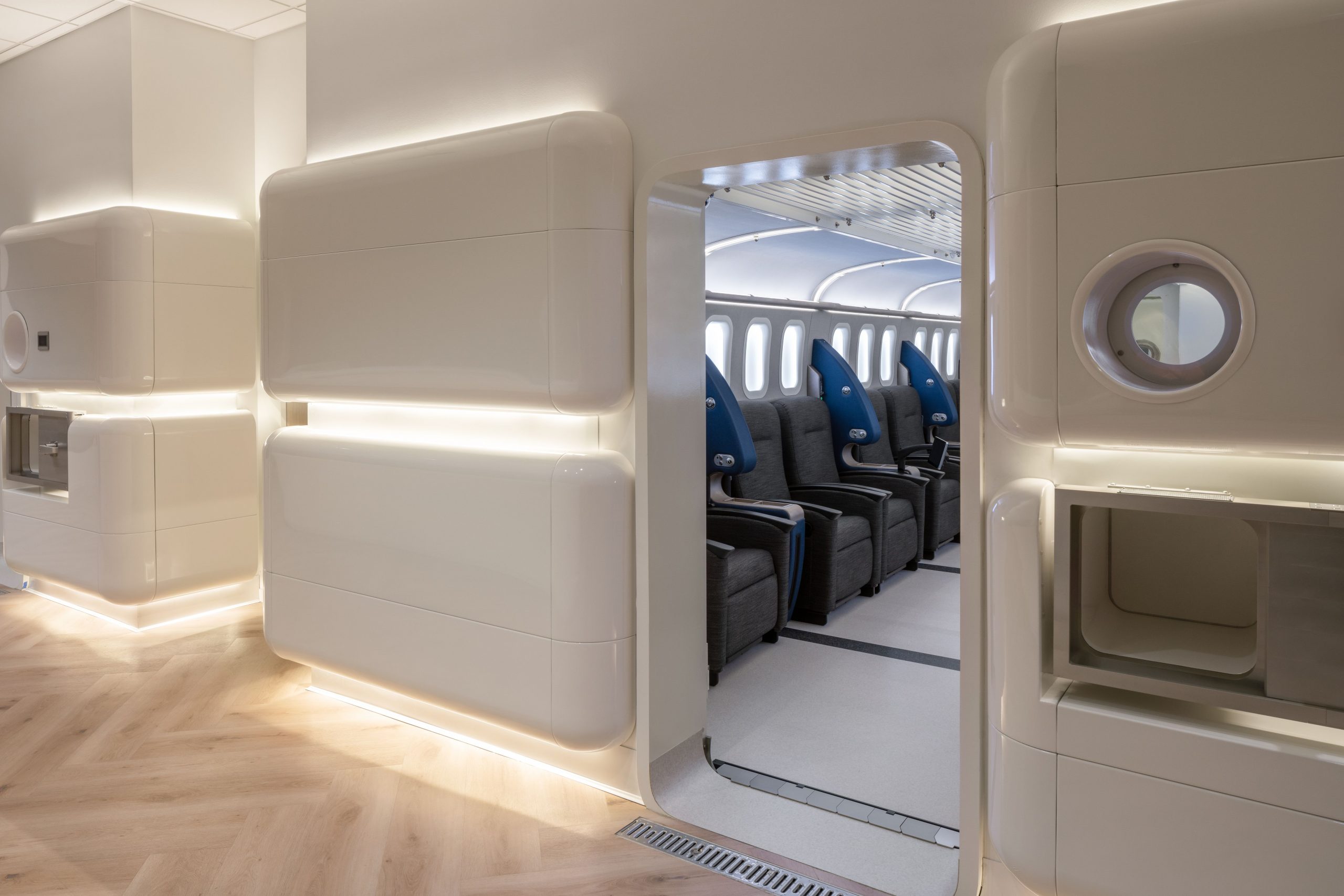
Aviv Clinics – Multiplace HBOT suite
What about soft-sided “mild” chambers?
A growing number of people are asking this hyperbaric oxygen therapy question, as many clinics tout the use of soft-sided “mild HBOT” chambers. However, these portable bag chambers are only approved for treating altitude sickness. They also operate at much lower pressures than hard-sided monoplace and multiplace chambers, limiting their therapeutic effect. Additionally, many clinics that offer “mild HBOT” often don’t meet the rigorous regulatory or fire safety code requirements for HBOT facilities.
2. What Conditions or Goals Does This HBOT Program Support?
HBOT can be used for a wide range of medical and wellness goals. Some clinics treat only acute wounds or infections, while others, like Aviv Clinics, offer research-backed programs that address cognitive decline, brain injury, PTSD, and more. Choose a clinic aligned with your specific condition or health objective.
Traditional HBOT facilities only treat acute conditions like gangrene, infections, burns, or decompression sickness. HBOT has been used for decades to treat these “on-label” conditions, which are typically urgent, treated at hospitals, and covered by insurance. In these instances, the number of HBOT treatments can be as few as one or two sessions.
Other facilities offer spa-like experiences, providing “wellness” dives without a clear protocol or clinical oversight.
In contrast, the research-backed Aviv Medical Program treats conditions that affect brain and body function. These include:
- Age-related cognitive and physical decline
- Stroke recovery
- Traumatic brain injury (TBI) and post-concussion syndrome
- PTSD
- Fibromyalgia
- Long COVID
- Lyme disease
- Chronic carbon monoxide poisoning
- Athletic performance issues
- Surgical recovery
3. Is the HBOT Protocol Backed by Scientific Research?
Many facilities offer hyperbaric oxygen therapy without peer-reviewed evidence or standardized protocols. Ask whether the treatment is rooted in science, and how the facility’s protocols compare to those used in the clinical trials. Every treatment you choose can affect your body positively or negatively, so doing your research and choosing a reputable clinic is paramount.
The pressure and length of treatments, as well as the oxygen dosage used in Aviv’s HBOT treatments, are the result of peer-reviewed scientific research. Aviv Clinics’ HBOT treatment protocol is based on nearly two decades of rigorous, published research. It was developed at the Sagol Center for Hyperbaric Medicine and Research, the world’s most advanced facility of its kind. The Aviv Protocol is uniquely designed to spark the body’s innate capacity for regeneration using oxygen fluctuation techniques, a method known in the scientific community as the hyperoxic-hypoxic paradox. In clinical trials, this protocol has proven to stimulate stem cell activity, reduce inflammation, and improve blood flow in the brain and tissues.
Notably, this protocol is difficult to replicate in single-person monoplace chambers and is not possible to administer in low-pressure “mild” chambers.
4. Who Makes Up the Clinical Team Supporting the HBOT Program?
An important hyperbaric oxygen therapy question is to ask about the type of expert on-site support available for treatment and guidance. Some clinics operate more like spas, with minimal or no clinical oversight by an on-site physician. Others focus narrowly on wound healing, with limited scope for treating complex or neurological conditions.
At Aviv Clinics, clients have access to a multidisciplinary team that includes:
- Hyperbaric physicians
- Clinical psychologists and neuropsychologists
- Physical therapists
- Physiologists
- Nutrition specialists
- Nursing professionals
5. Will Medical Staff Be Present During My HBOT Sessions?
Hyperbaric oxygen therapy is a medical treatment, so professional oversight and support during your sessions are critical. Some facilities and spas offering mild HBOT don’t even have a physician on site during treatments, or choose to monitor clients remotely via video feed.
Aviv Clinics offers a medically supervised HBOT experience:
- A nurse or other medical professional is inside the multiplace suite to provide care during every session
- A trained hyperbaric technician monitors each session from a control console next to the HBOT suite
- A physician is on site at all times during hyperbaric treatments.
Your safety and comfort are always top priorities.
6. What Pre- and Post-Treatment Assessments are Included?
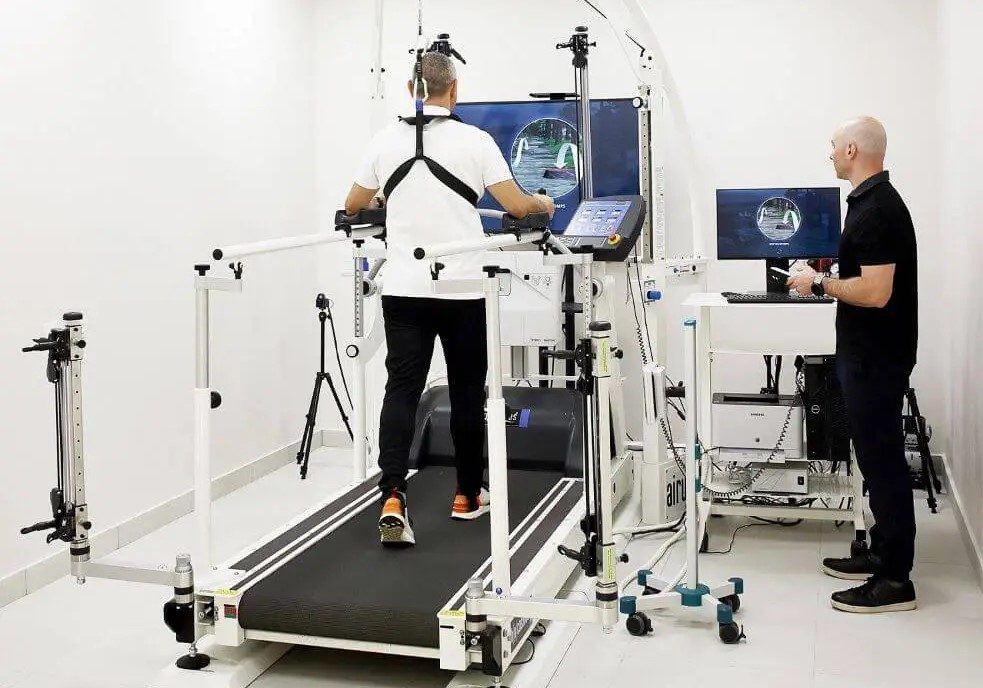
If a clinic doesn’t offer detailed assessments before and after treatment, there’s no objective way to track your progress. At a minimum, your provider should conduct a detailed medical history and physical examination and a chest x-ray before hyperbaric treatment. Depending on your individual needs, you may also need blood work or heart and lung function testing to determine your suitability for the treatment.
In addition to these assessments, the Aviv Medical Program can include the most comprehensive battery of pre- and post-treatment evaluations available.
At your request, these cognitive and physical tests can include:
- Extensive blood panels
- High-resolution brain imaging with MRI or SPECT
- Cognitive testing to measure memory, attention, and other cognitive domains
- Cardiopulmonary exercise test (CPET)
- Body composition analysis
- Gait, balance, and overall motor function assessment
- Stem cell count and assessment of aging biomarkers
These assessments help define your health goals, guide your physician-prescribed treatment plan, and track measurable improvements.
7. Will I Receive a Detailed Report of My HBOT Progress?
Too often, clients leave HBOT clinics with no clear understanding of their results. Some facilities that work on a session-to-session basis may only provide minimal or per-visit tracking. Others may not offer results at all.
While some of our clients are perfectly happy with simply “feeling better,” others prefer a detailed before-and-after report. For those clients, we offer in-depth post-treatment reporting. Depending on your condition or reason for treatment, this report may track changes in:
- Physical health
- Cognitive performance
- Brain imaging
- Aging biomarkers
- Cellular health
- Condition-related metrics
Clients review their progress one-on-one with their Aviv Clinics physician, who explains and interprets the data and provides next steps.
8. Will The HBOT Clinic Coordinate With My Physician?
Some hyperbaric clinics operate outside the traditional medical system and don’t communicate with your personal healthcare team. If you’re working with a physician, specialist, or other provider, it’s important to choose an HBOT program that can integrate with your broader care plan.
At Aviv Clinics, we consider ourselves part of your overall care team. With your permission, we’ll coordinate directly with your existing physicians, share your assessment data and progress reports, and provide pre- and post-program evaluations for your permanent medical record.
Some clients are hesitant to tell their doctors that they’re exploring HBOT or other nontraditional therapies, but Aviv Clinics encourages transparency. In fact, many physicians are excited when they learn about the science behind our program and the measurable improvements their patients experience. We believe collaboration leads to better outcomes, and we’re here to support your health journey from every angle.
The Bottom Line: Not All HBOT is Equal
Before you invest time and money, make sure you know what you’re getting by asking these hyperbaric oxygen therapy questions. Your HBOT treatment protocol should be scientifically validated, supported by a caring, expert medical team, and offer a full range of assessments to show your progress.
This comprehensive approach allows Aviv Clinics’ clients to improve memory, regain physical stamina, and live with greater clarity and resilience.
Contact us to learn more about the Aviv Medical Program and how it can benefit you.
Last Update: July 10, 2025
How Hyperbaric Oxygen Therapy Can Improve Blood Flow, Brain Health and Aging Outcomes
Blood circulation is one of the most important functions in our bodies.
Without the circulation system, the brain, heart, and other vital organs couldn’t receive the oxygen we need to function properly and survive. Good circulation keeps your mind sharp, your heart strong, and can even give your complexion a youthful flush. It is vital to staying strong, healthy, and energetic throughout your life.
However, the aging process can slow the flow of blood throughout the body. This can cause all manner of health problems and leave you feeling tired, sluggish, and weak. Fortunately, there are ways to combat poor circulation caused by the aging process. An innovative treatment protocol based on hyperbaric oxygen therapy (HBOT) has been clinically proven to improve the flow of blood throughout the body and can even promote the creation of new blood vessels in the brain and other vital organs.
So, how does hyperbaric oxygen therapy work to improve blood flow?
How Aging Impacts Blood Circulation and Overall Health
As we age, the number of blood vessels in our bodies naturally decreases. Blood vessels are a critical part of the circulation system through which our organs receive oxygen to work properly. As smaller, tinier blood vessels naturally die off, organs no longer receive as much oxygen as they once did.
For the brain, losing circulation and not getting enough oxygen can mean losing cognitive function. You may experience brain fog or memory problems. It can be small things, such as struggling to remember where you put your keys, to more extensive neurological problems like vascular dementia.
But our brains aren’t the only organs affected by poor circulation. A lack of blood flow can affect every part of the body. In men, a lack of blood flow can lead to erectile dysfunction or other problems with sexual health. Poor circulation can also lead to tingling or numbness in the hands and feet, muscle cramps, or swelling and pain in the limbs. It can leave you feeling sluggish and sleepy, or even leave your skin dry and discolored due to the lack of oxygen.
How can you combat the restricted blood flow caused by aging?
Hyperbaric Oxygen Therapy (HBOT) and Blood Flow: How it Works
Angiogenesis: New Blood Vessels for Better Oxygenation
At one time, scientists believed that the blood vessels lost to aging were gone forever. New research has revealed otherwise. Studies have demonstrated that Hyperbaric Oxygen Therapy (HBOT) can directly improve blood flow. During an HBOT session, patients breathe 100% oxygen in a high-pressure environment, like the multiplace HBOT suites used at Aviv Clinics.
If hyperbaric oxygen therapy is delivered using a specific protocol, the increased levels of oxygen in the body can promote a process called angiogenesis. Angiogenesis is the growth of new blood vessels in the body. This process increases blood flow, helping deliver vital oxygen to organs that have been slowed by age, illness, or other conditions. Angiogenesis can rejuvenate and repair your body, and the scientifically proven benefits are promising.
Cognitive Benefits: What Better Circulation Means for Your Brain
Because angiogenesis rebuilds blood vessels, it directly promotes improved circulation in all parts of the body. In the brain, improved circulation can lead to improved cognitive function.
HBOT was shown to directly benefit the cognitive performance of patients who had all suffered a stroke up to 36 months before the research study and had at least one motor dysfunction. Patients who received a two-month protocol of HBOT treatment experienced significant improvements to their neurological functions. In some of the most dramatic results, patients regained their ability to speak, their ability to read and write, and some even regained function in paretic limbs.
It’s not just stroke patients who can benefit from angiogenesis. More studies reveal how increased blood flow can improve brain function in healthy older adults. SPECT imaging scans of patients’ brains before and after HBOT treatment reveal significant improvements to cerebral blood flow and improved function in different areas of the brain.
The results? These improvements directly correlate to increased attention spans, higher information processing speed, and improved executive function.
Whole-Body Wellness: Energy, Vigor, and Healing Through Angiogenesis
The angiogenesis produced by HBOT can help more than just your brain. Angiogenesis can benefit your entire body. Good circulation can increase energy levels and leave you feeling more youthful and active. You may find yourself up for more vigorous physical activities, and even increased sexual activity.
In one published study, 30 men with erectile dysfunction saw significant positive outcomes thanks to the increased blood flow from angiogenesis. The men, who averaged around 59 years of age, all reported greater overall sexual satisfaction after undergoing HBOT. Women may also benefit from improved circulation, since female arousal and sexual satisfaction also depend on proper blood flow.
Other benefits of having good circulation can include faster wound healing and more youthful-looking skin, since angiogenesis promotes tissue regeneration. Good blood flow affects every aspect of your life, keeping you healthy and strong. Undergoing HBOT programs like the unique, evidence-based protocol available at Aviv Clinics can directly promote good circulation throughout the body.
The Aviv Difference: A Personalized Program for Lasting Results
While research indicates that HBOT can produce amazing results on its own, at Aviv Clinics, we emphasize the importance of treating the whole body. Having a poor diet and living a sedentary lifestyle can contribute to poor circulation and worsen the effects of aging. Maintaining a healthy lifestyle is essential for the benefits of HBOT to last. Think of it as doing maintenance on a car after undergoing an extensive series of repairs.
This is why our clients are supported by a multidisciplinary team of professionals. Our physicians prescribe a personalized Aviv Medical Program for each client, depending on that client’s health history, conditions, and lifestyle. Although Aviv is the largest non-military hyperbaric facility in the United States, our program goes far beyond HBOT to promote improved blood flow. In addition to a unique, evidence-based hyperbaric oxygen therapy protocol, clients may also be prescribed cognitive exercises, physical training, nutritional counseling, or other therapies. At the end of the Aviv Medical Program, clients are well-equipped with the tools they need to maintain the benefits of good circulation.
Contact us to learn more about the Aviv Medical Program and determine if it’s the right fit for you.
Last Update: July 3, 2025
Hyperbaric Oxygen Therapy for Stroke Recovery: Exploring Advanced Rehabilitation Options
Understanding Stroke and Its Long-Term Effects
Strokes are “a leading cause of serious long-term disability” in the United States. Given that “87% of all strokes are ischemic,” or caused by artery or vein blockage, it makes sense that most patients suffer long-term functional impairments. However, medical research is offering hope in the form of hyperbaric oxygen therapy for stroke recovery.
Stroke-related impairments can range from paralysis, speech difficulties, and sensory issues to an array of other cognitive and physical challenges. Additionally, many stroke patients have had a stroke before—“nearly 1 in 4” survivors have suffered at least one stroke previously.
Fortunately, multiple rehabilitation options are available for stroke patients, including hyperbaric oxygen therapy (HBOT). We dive into the key details below.
Remember that each person’s medical condition and background are entirely unique. Thus, speaking with a physician about treatment options is essential to getting back to optimal health.

Common Stroke Rehabilitation Options to Consider
Stroke relief generally entails working with a diverse medical team of physicians, nurses, and therapists. This support team may recommend one or more of the following options:
-
Speech Therapy for Post-Stroke Communication Challenges
Stroke patients can experience speech challenges, ranging from slurred words to significant difficulties with oral communication or understanding people (aphasia). This is due to damage to the “left side of the brain that controls speech and language.” Cases like this often merit speech therapy.
Patients work with speech-language pathologists (SLPs) to relearn techniques such as:
- Controlling the mouth and throat muscles to speak more clearly and adequately swallow
- Participating in cognitive language exercises to restore communication and comprehension skills
Research illustrates that early speech intervention with aphasia patients “had a massive increase in their ability to communicate at 12 and 26 weeks after their stroke.” Patients could speak better and exhibited less difficulty finding and using the right words.
-
Physical Therapy: Regaining Mobility and Strength
A physical therapist (PT) engages patients in movement exercises to help them reacquire motor skills. PTs generally help stroke patients relearn activities such as walking, sitting, standing, and switching from one movement to another.
Medical experts believe consistent PT lowers “risks of hospital readmission within a month after discharge” because it helps patients:
- Restore movement and accomplish tasks
- Plan for the next step of post-acute care (e.g., patient rehab facility, skilled nursing facility, or home care assistance)
-
Occupational therapy: Restoring Daily Living Skills
Occupational therapists help patients carry out everyday activities. They aim to help stroke patients live as independently as possible. OTs work with post-stroke patients to assess how the stroke has affected their lifestyle.
For those who have difficulties dressing, cooking, or bathing, the OT will find solutions to help carry out these activities of daily living to the best of their ability. These statistics outline the importance of OT in the recovery process:
- One study of Medicare claims data found that “Rehabilitation services including physical therapy and occupational therapy play important roles in promoting functional recovery and preventing deconditioning during acute hospitalizations.” However, “Only 61% of patients with ischemic stroke received both physical therapy and occupational therapy services in the acute setting.”
- A separate study notes that patients who participated in OT programs focused on impairment and basic living activities “progressed to more advanced activities over time (e.g., less bed mobility, more home management).”
- Research indicates the key to succeeding in a post-stroke treatment plan is “well-focused, repetitive practice.” The more patients practice, the more they will succeed in getting back to optimal health.
The Role of Hyperbaric Oxygen Therapy (HBOT) in Stroke Rehabilitation
An up-and-coming therapy for long-term stroke recovery that has shown promise in clinical research is Hyperbaric Oxygen Therapy (HBOT). HBOT has clear indications of neuronal rehabilitation in patients suffering from post-stroke disabilities.
HBOT and its apparent benefits for post-stroke patients were studied and reviewed in an article published in the peer-reviewed journal PLOS One:
- The participants were exposed to a unique HBOT protocol, including daily sessions over two months. All the patients showed improved neurological functioning, indicating “that HBOT can lead to significant neurological improvements in post-stroke patients even at chronic late stages.”
- Noticeable recovery included “regained speech (almost fluent) and reading capabilities.” Even in patients with less dramatic results, everyday tasks like bathing and dressing became possible unaided by the end of the treatment period.
- Patients were further assessed using brain metabolism imaging (SPECT scans) to examine brain activity during the HBOT treatment. “The SPECT after HBOT demonstrated the disappearance of the perfusion lesions.”
- The study indicated a link between oxygen and stroke: “Increasing the plasma oxygen concentration with hyperbaric oxygenation is a potent means of delivering to the brain sufficient oxygen for tissue repair.”
Not only did the study determine significant improvements in patients treated with HBOT, it also crucially found that the progression occurred in patients even years after the stroke event.
The study’s objective was to “evaluate the effects of HBOT started in the late-chronic phase after the acute stroke.” All the patients experienced strokes between six and 36 months prior to the HBOT treatment.
The Aviv Medical Program: A Personalized Approach to Stroke Recovery
Backed by over a decade of research, the Aviv Medical Program can include this same evidence-backed HBOT protocol. The program aims to offer patients a customized, coordinated, and multidisciplinary health plan to address their specific goals. Aviv Clinics is the largest and most advanced civilian hyperbaric medicine clinic in the United States, but Aviv offers much more than HBOT for stroke recovery.
As a stroke can affect every person differently, each Aviv Clinics plan is individualized based on a patient’s post-stroke recovery needs. In addition to HBOT, Aviv’s clinical team and physicians may prescribe cognitive training, physical performance training, dietary coaching, or other interventions to help you recover, even long after a stroke.
Here’s how our process works:
- Assessment: Our dedicated team will conduct a thorough assessment to gain an understanding of your health and craft a personalized health plan.
- Treatment: Under the supervision of Aviv’s medical staff, the treatment plan will entail one or more types of treatment that are meant to get you on the road to recovery.
- Analysis: At your request, our team will initiate the same assessment at the end of your treatment to measure improvements and recommend next steps.
Real-Life Stroke Recovery: Keren’s Journey with HBOT and Aviv Clinics
A holistic treatment plan that addresses the mind and body is key to successful recovery. Former Aviv Clinics patient Keren Trabelsi is a true testament to this fact.
Businesswoman and mother Keren Trabelsi suffered an ischemic stroke, causing paralysis on the left side of her body. The stroke also caused cognitive issues that made daily tasks difficult, which did not make her feel as capable as she had been before. She sought the help of Aviv Clinics.
Now, 13 months later, she can walk comfortably, type with her left hand again, and engage in cognitive activities like crossword puzzles and sudoku.
“[Aviv Clinics is] like driving a Ferrari on the road to recovery versus driving like an old beaten-up car….”
Stay current on our client success stories to learn more about what the Aviv Medical Program can help you achieve.
Is the Aviv Medical Program Right for Your Stroke Recovery Needs?
If you’ve been experiencing cognitive or physical challenges since your stroke, the Aviv Medical Program may be able to help. We have treated thousands of patients suffering from various conditions, enhancing their quality of life.
We encourage you to speak with one of our board-certified physicians to see if it’s right for you, as each person’s body, medical history, and circumstances differ. Our staff will take the time to understand your health history, symptoms, and goals. This process will help us determine whether the Aviv Medical Program is appropriate for you.
How Long Does It Take to See Results?
Improving physical and cognitive performance does not happen overnight. The Aviv Medical Program requires time and careful compliance to achieve success.
HBOT sessions take approximately two hours daily, five days a week, for up to 12 weeks. Depending on your individual needs, you may also be prescribed additional therapies like cognitive exercises, dietary coaching, and physical performance training with our clinical team.
Taking the Next Step: Learn More About Stroke Recovery With Aviv Clinics
If you need help finding a stroke recovery plan, contact Aviv Clinics. Our diverse team of medical professionals is experienced in crafting customized treatment plans that have brought significant and fulfilling results for our patients.
Improving your quality of life begins at Aviv Clinics.
Last update: June 13, 2025
New Study Shows Hyperbaric Oxygen Therapy May Induce Cognitive Improvements
In the past hundred years, life expectancy has risen from 55 to 80. Scientific advancements like innovative drug therapies, medical devices, and modern diagnostic and treatment methods have all played a role in this. While lifespan has increased substantially, our ‘healthspan’ has not improved as rapidly, in particular when it comes to brain health.
Our lifestyle, specifically diet, physical and mental exercise, has long been recognized to impact cognitive function, especially as we get older. Foods, fitness machines and mobile apps abound, explicitly aimed at helping older generations retain their youth. However, drugs and other therapies to significantly fight age-linked cognitive decline have so far proved elusive.
A recently published study has shown that an innovative and unique Hyperbaric Oxygen Therapy (HBOT) protocol is emerging as an essential therapy for reversing an age-related decline in cognitive function.
HBOT for Enhancing Brain Function
Dr Shai Efrati, Dr Amir Hadanny, and a team at the Sagol Center for Hyperbaric Medicine and Research at Shamir Medical Center, led a new study published in the peer-reviewed journal Aging. This research demonstrated the benefits of the unique HBOT protocol developed at the Shamir Medical Center.
The study was a collaboration between the Sackler School of Medicine and Sagol School of Neuroscience at Tel Aviv University.
The study was the first randomized, controlled clinical trial exploring the effect of HBOT on cognitive functions in healthy aging adults. It revealed that HBOT was especially beneficial for the participants in improving comprehensive cognitive functions: attention, information processing speed, and executive function.
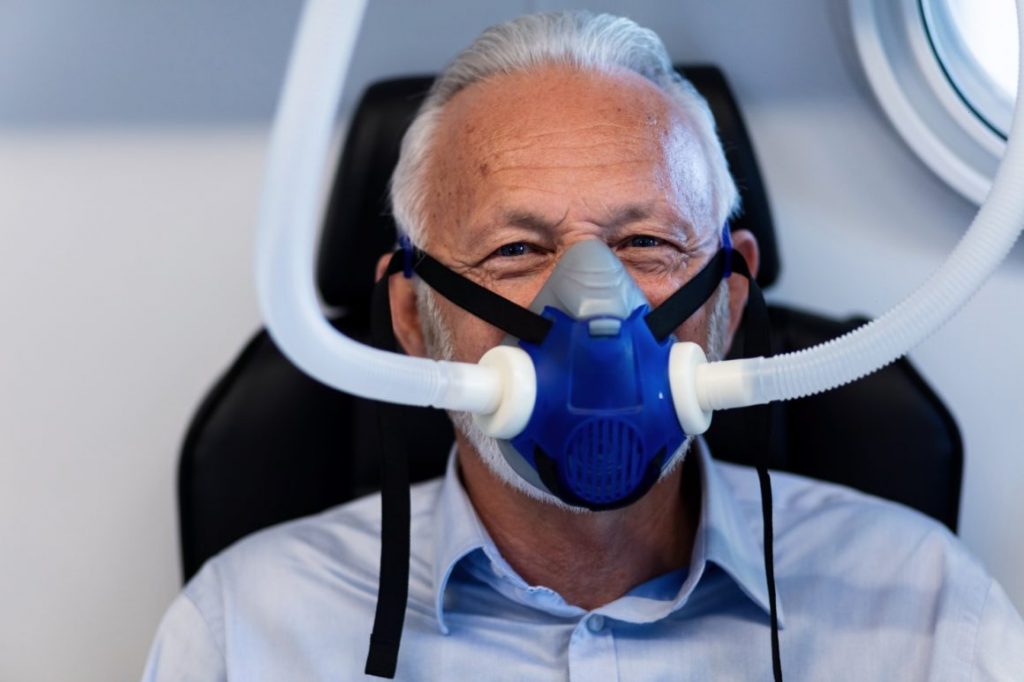
HBOT is emerging as an essential therapy in reversing an age-related decline in cognitive function.
HBOT’s Role in Reversing Age-Related Cognitive Decline
Dr Efrati issued a statement marking the publication of the study, in which he underlines the consequences and concerns related to the decline in cognitive and functional ability in highly developed societies:
“Major research efforts around the world are focused on improving the cognitive performance of the so-called ‘normal’ ageing population,” Dr Efrati said. “In our study, for the first time in humans, we have found an effective and safe medical intervention that can address this unwanted consequence of our age-related deterioration.”
Dr Hadanny added that the treatment has now been in use for several years, and scientists have begun to comprehend how brain function can be restored with HBOT.
“In the past, we have demonstrated HBOT’s potential to improve/treat brain injuries such as stroke, traumatic brain injury and anoxic brain injury (due to sustained lack of oxygen supply) by increasing brain blood flow and metabolism,” Dr Hadanny concluded: “This landmark research could have a far-reaching impact on the way we view the ageing process and the ability to treat its symptoms.”
Mechanism of Hyperbaric Oxygen Therapy
Though the brain accounts for only 2% of body mass, it utilizes over 20% of an individual’s oxygen intake. Physical and cognitive decline can often be ascribed to a decrease in the efficiency of oxygen processing associated with aging.
The HBOT protocol targets this problem by placing patients in a pressurized hyperbaric suite, where patients breathe 100% oxygen. This raises oxygen in the body tissue by between 10 to 15 times above normal. Oxygen levels are then fluctuated in this unique protocol, which the research team says leads to the release of growth factors and stem cells that promote healing.
Conclusions on Oxygen and Brain Function
The study enrolled sixty-three healthy, vigorous adults who were subjected to HBOT for two hours a day, five days a week, for three months. Their cognitive function was measured using a comprehensive series of computerized cognitive appraisals. Cerebral blood flow was quantified by using a magnetic resonance imaging technique that observes the journey blood takes through the organs and tissues, known as brain perfusion.
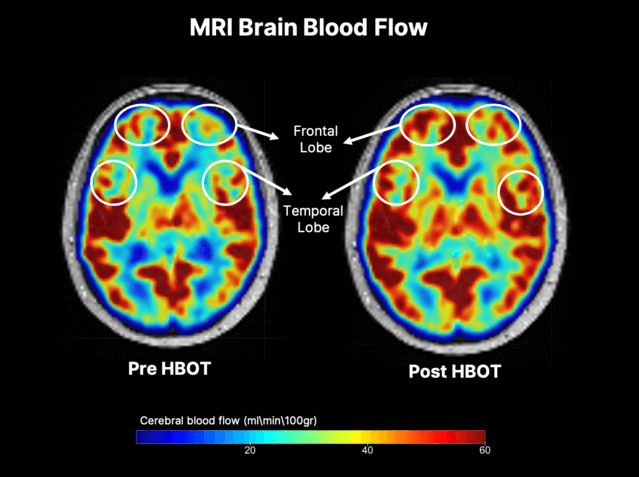
Amongst the essential conclusions of the analysis was the correlation between the above-noted improvements and cerebral blood flow to different areas of the brain.
The study bolsters the current data regarding the efficacy of HBOT in generating brain function. Noticeably, the combination of pure oxygen and higher pressure led to increases in tissue oxygenation while simultaneously focusing on pressure-sensitive genes. Combined, these enhanced and restored tissue metabolism. This was the first time that such benefits had been observed in healthy patients, as previous studies had focused on patients with cerebral impairments due to a range of conditions.
HBOT and Reversal of Cognitive Decline in Aging
Amplified blood flow to the brain preceded the noted improvements in the participants’ attention and cognitive processing speeds. HBOT enhanced cerebral blood flow and regenerated brain cells and blood vessels in individuals with no brain damage. Previous studies had concentrated on the benefits to patients with post-stroke, traumatic, and anoxic brain injury
These improvements in overall cognitive function were still observable six months after treatment. Dr. Efrati, writing in Psychology Today, proposed that the technique might even reverse damage to brain tissue. He further noted that this would be the first time an effective medical intervention had been observed to reverse age-related cognitive decline.
“Most drugs and interventions are at best slowing the expected decline,” he said. “For the first time in humans, we have discovered a way to regenerate the ageing brain — as can be seen by brain MRI — and enable us to gain back the cognitive function of our younger selves.”
Aviv Clinics in central Florida is now using this research-based protocol. To learn more and discover if the personalized Aviv Medical Program is right for you contact the clinic:
Breakthrough Study Shows Hyperbaric Oxygen Treatments Helps Stop Biological Aging
A landmark study from researchers in Israel has found that hyperbaric oxygen therapy (HBOT) improves two key biological signs of aging in humans – the first study to ever make this finding. The research shows it’s possible to target the aging process at the basic cellular-biological level. This breakthrough in biology of aging research provides scientists a new foundation for investigating ways to slow the aging process.
Published in the peer-reviewed journal Aging, the study involved patients aged 64 and older who went through a series of HBOT treatments. Blood tests taken over the course of the study showed hyperbaric oxygen treatment improved two common signs of biological aging – a shortening of telomeres on chromosomes and the accumulation of senescent cells.
The significance of this is difficult to overstate. Telomeres are nucleotide sequences that protect the ends of chromosomes from deterioration or fusion with other chromosomes. A shortening in their length of about 20 to 40 bases per year is associated with serious life-threatening illnesses. Stopping and reversing telomere shortening has long been considered a key to slowing biological aging.
Senescent cells inhibit cell proliferation. The accumulation of senescent cells contributes to age-associated conditions and illnesses. Eliminating them can improve those conditions and illnesses, according to past animal studies.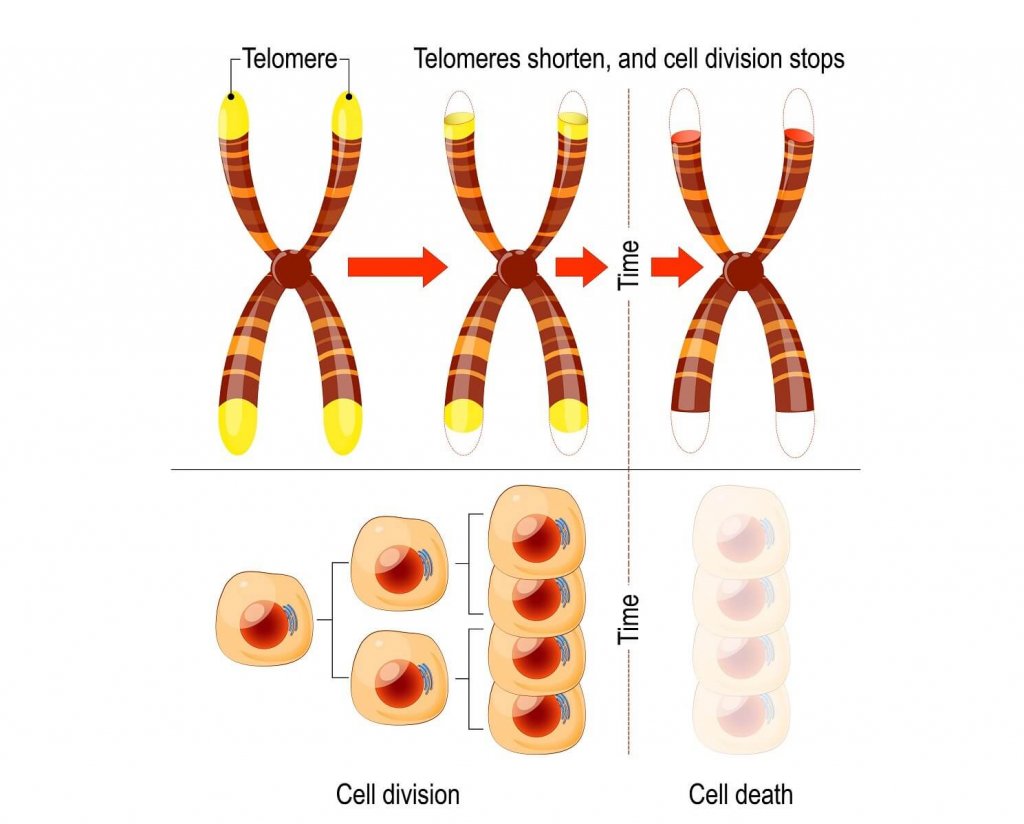
The “Holy Grail” of the Biology of Aging
The new study is part of an ongoing comprehensive aging research program in Israel. A previous study, released earlier in 2020, showed that HBOT also improves cognitive function.
“After dedicating our HBOT research to exploring its impact on the areas of brain functionality and age-related cognitive decline, we have now uncovered for the first time in humans HBOT’s biological effects at the cellular level in healthy aging adults,” Dr. Shai Efrati, director of the Sagol Center for Hyperbaric Medicine and Research at the Yitzhak Shamir Medical Center and a co-author on the study, said in a news release.
Efrati called telomere shortening “the ‘Holy Grail’ of the biology of aging” and noted that researchers are exploring many pharmacological and environmental interventions in the hope of enabling telomere elongation.
“The significant improvement of telomere length shown during and after these unique HBOT protocols provides the scientific community with a new foundation of understanding that aging can, indeed, be targeted and reversed at the basic cellular-biological level,” said Efrati, who also holds an associate professor position at the Sackler Faculty of Medicine and the Sagol School of Neuroscience at Tel Aviv University.
How The Study Was Conducted
Efrati co-authored the study with Dr. Amir Hadanny, Chief Medical Research Officer of The Sagol Center for Hyperbaric Medicine and Research. The two focused on testing the impact of HBOT on telomere length and senescent cell concentrations in a non-pathological, aging adult population.
Efrati and Hadanny conducted the prospective trial with 35 healthy, independent adults. None of the patients made any changes to their lifestyle, diet or medication during the study. Each received 60 daily HBOT sessions over the course of 90 days.
Whole blood samples were collected before treatment and again at the 30th and 60th sessions. Their blood was checked again one to two weeks following the last HBOT session to assess peripheral blood mononuclear cells (PMBCs) telomere length and senescence.
The study found that certain HBOT protocols induced regenerative effects.
Some telomeres increased by more than 20% in length, while senescent cells decreased in number by as much as 37%.
Dr. Hadanny said the pioneering study has
“opened the door for further research on the prolonged cellular impact of HBOT to reverse the aging process.”
He said that up until the study, only lifestyle modifications and intense exercise showed the ability to slow telomere length shortening.
“What is remarkable to note in our study is that in just three months of HBOT, we were able to achieve such significant telomere elongation – at rates far beyond any of the current available interventions or lifestyle modifications,” said Dr. Hadanny.
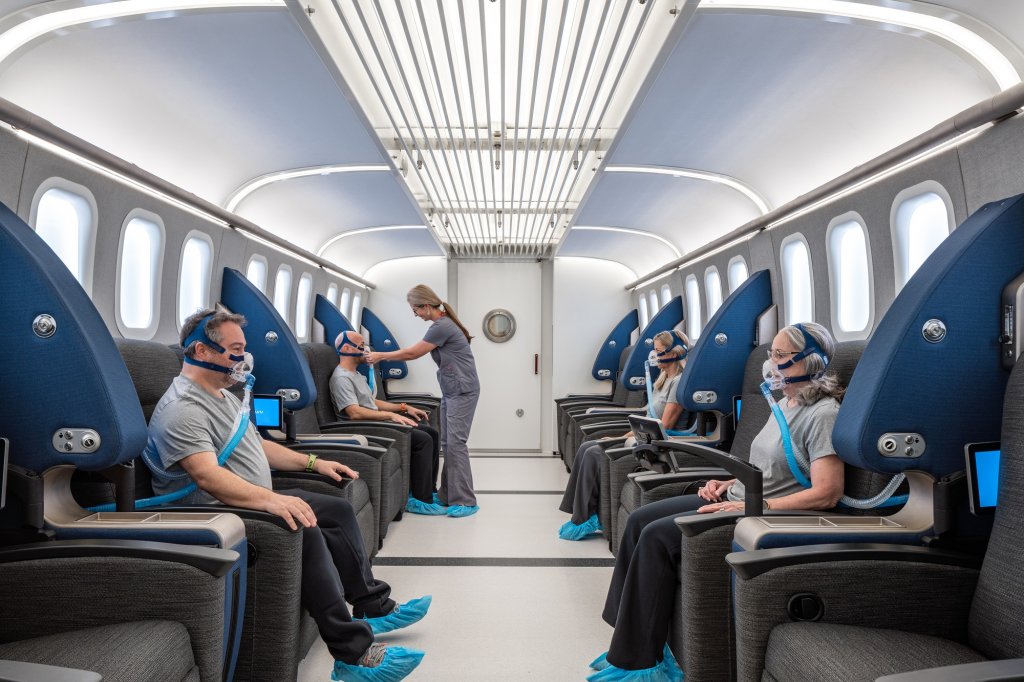
Dr. Efrati is chair of the medical advisory board to Aviv Scientific LTD, which offers HBOT treatments, cognitive and physical training and nutritional coaching to enhance brain and body performance at Aviv Clinics. Aviv Clinics is located at the Center for Advanced Healthcare at Brownwood in The Villages, Florida. For more information or to schedule a consultation, contact the clinic.

